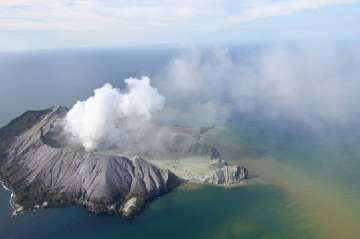Nearly 13 people were feared dead while many others remained missing after a volcano off the New Zealand coast erupted in a towering blast of ash and scalding steam. Five deaths have been confirmed so far due to the volcanic eruption. Rescue efforts were also hampered due to the unstable weather conditions in the region. Helicopter crews had landed on White Island despite the danger and helped evacuate many survivors, some of them suffering critical burns.
Officials, however, said they were still working with scientific experts to determine when it would be safe to return to the island to search for the missing.
Aircraft have flown over the island repeatedly, and “no signs of life have been seen at any point,” Prime Minister Jacinda Ardern said.
Russell Clark, an intensive care paramedic worker, said the scene looked like the Chernobyl nuclear disaster, “just blanketed in ash.
The eruption sent a plume of steam and ash an estimated 12,000 feet (3,660 meters) into the air. One of the rescue boats that returned from the island was covered with ash half a meter (yard) thick, Ardern said.
“It was quite an overwhelming feeling. There was a helicopter on the island that had obviously been there at the time, with its rotor blades off it,” Clark told New Zealand broadcaster TVNZ. “I can only imagine what it was like for the people there at the time — they had nowhere to go.
“We didn’t find any survivors on the island,” Clark said. “It would’ve been quite traumatic for them.”
Video shows deadly volcanic eruption in New Zealand
White Island, also known by the indigenous Maori name Whakaari, is the tip of an undersea volcano some 30 miles (50 kilometers) off mainland New Zealand. Scientists had noted an uptick in volcanic activity in recent weeks, and questions were being raised about why tourists were still being allowed on the island.
Many of the 47 visitors on the island at the time of the eruption were Australian, and Ardern said New Zealanders and tourists from the United States, China, Britain and Malaysia were also affected. Some of the visitors were passengers from the Royal Caribbean cruise ship Ovation of the Seas.
Australian Prime Minister Scott Morrison said 11 Australians are unaccounted for and 13 were hospitalized.
Three Australians were suspected to be among the initial five confirmed dead, he told reporters in Sydney. “I fear there is worse news to come,” Morrison said.
A few locals laid flowers Tuesday at a fence on the waterfront near where the rescue boats had returned with the injured, many of whom were flown to hospital burn units around the country.
New Zealand’s GeoNet seismic monitoring agency had raised the volcano’s alert level on Nov. 18 from 1 to 2 on a scale where 5 represents a major eruption, noting an increase in sulfur dioxide gas, which originates from magma deep in the volcano.
It also said that volcanic tremors had increased from weak to moderate strength. It raised the alert level to 4 for a time after Monday’s eruption but lowered it to 3 as activity subsided.
White Island is New Zealand’s most active cone volcano. About 70 per cent of the volcano lies under the sea.
Twelve people were killed on the island in 1914 when it was being mined for sulfur. Part of a crater wall collapsed and a landslide destroyed the miners’ village and the mine itself.
The remains of buildings from another mining enterprise in the 1920s are now a tourist attraction. The island became a private scenic reserve in 1953, and daily tours allow more than 10,000 people to visit every year.
Also Read | Deadly volcano rocks New Zealand: 5 killed, tourists missing
Also Read | Italy's Mount Etna volcano erupts, closes 2 nearby airports
Latest World News
